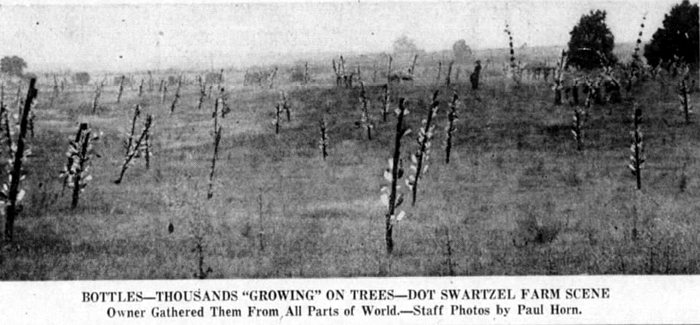Winter Zero’s Musical Bottle Farm
From the 1930s to the 1950s, one of the most popular oddities to visit in Ohio was Winter Zero Swartsel's "Bottle Farm" located outside of Farmersville. (He said he got his name because he was born on a "hard, cold winter day.") Here's a description of it from the historical marker now at the site:
Curious that there were no visitors from Delaware.


Here's another description of the Bottle Farm from "Joe" on Angelfire:


News reports indicate that Swartsel wasn't on the best of terms with the surrounding community. He had a habit of shooting at teenagers whom, he claimed, were trespassing on his property.
When he died in 1953 the city tried to preserve the Bottle Farm as a tourist attraction but gave up after two years and auctioned everything off. Today the historical marker is the only reminder of the Farm's existence at the location.
While chiding the American people for their wastefulness and abusing their environment, his 22 acres of farmland became his artist's canvas filled with the thousands of items he collected from the “wasteful.” Winter Zellar (Zero) Swartsel's farm property became a field of glass as he adorned it with sculptures and “art” using glassware of all kinds, bells, bed frames, wood, and other discarded items. His finest works, fashioned from bottles titled “Kindly Light” and “Full Measure” created the popular Farmersville Bottle Farm. The farm also provided interesting listening experiences. In addition to the bells and twinkling glass that rang out in the wind, residents in town could count on hearing “The Old Rugged Cross” played on loud speakers on Sundays. Bells on grazing sheep added to the “noises” he described as restful. The farm attracted visitors from every state in the nation except Delaware.
Curious that there were no visitors from Delaware.


Here's another description of the Bottle Farm from "Joe" on Angelfire:
I grew up in the 1950's in a little town called Farmersville (population about 1000) in southwestern Montgomery County, Ohio. We lived on the western edge of town and about a mile out of town on that same road there existed a most peculiar farm called The Bottle Farm. Whenever we drove by, the most striking feature of this odd farm was that the fields bristled with poles driven into the ground at rather random locations. Each vertical pole had a series of glass bottles affixed to it at an angle to the pole, rather like very productive corn stalks with glass ears of corn and no leaves. Many of the glass bottles were of colored glass and it all glittered in the sunlight.
Scattered across the fields were heavy wooden structures that supported old church bells. To each bell's clapper was loosely wired an irregularly cut piece of tin painted flat black. Each piece of tin had some Indian words or a short phrase or saying scrawled across it in white paint. Whenever the wind blew, the pieces of tin would dance in the breeze and cause the clappers to clang the bells.
Scattered across the fields were heavy wooden structures that supported old church bells. To each bell's clapper was loosely wired an irregularly cut piece of tin painted flat black. Each piece of tin had some Indian words or a short phrase or saying scrawled across it in white paint. Whenever the wind blew, the pieces of tin would dance in the breeze and cause the clappers to clang the bells.

Dayton Daily News - Aug 18, 1954

Pittsburgh Press - Jun 12, 1938
News reports indicate that Swartsel wasn't on the best of terms with the surrounding community. He had a habit of shooting at teenagers whom, he claimed, were trespassing on his property.
When he died in 1953 the city tried to preserve the Bottle Farm as a tourist attraction but gave up after two years and auctioned everything off. Today the historical marker is the only reminder of the Farm's existence at the location.
Comments
It was his land and he could do what he wanted. He could have buried cars...
Posted by KDP on 11/23/21 at 11:35 AM
@KDP: or built a Carhenge.
Posted by Richard Bos on 11/27/21 at 04:55 AM
Commenting is not available in this channel entry.

Category: Eccentrics | Outsider Art